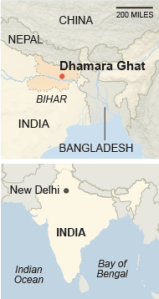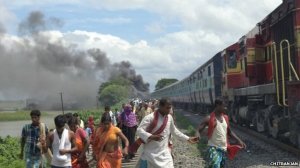 I’ve been away from my computer and traveling to some sites — I have much to tell, but for now, I must write about some serious global pilgrimage news from India. On August 19, an express train hit a crowd of Hindu pilgrims who were crossing the tracks in the eastern state of Bihar. The train came through as hundreds of pilgrims were disembarking from two passenger trains at Dhamara Ghat station. The Hindustan Times reports that the victims descending from the passenger trains were Hindu devotees rushing to the nearby Katyayani temple to mark the fourth and final Monday of the holy month of Sawan. Likewise, the NYT notes that the pilgrims were en route to offer holy water at the temple to Shiva; see also this BBC report. NBC news, however, notes that devotees were returning from offering morning prayers at Katyayani temple near Dhamara Ghat, a popular Hindu pilgrimage site. During the holy month of Sawan or Shravan, devotees of the Hindu deity Shiva head to holy sites across the country.
I’ve been away from my computer and traveling to some sites — I have much to tell, but for now, I must write about some serious global pilgrimage news from India. On August 19, an express train hit a crowd of Hindu pilgrims who were crossing the tracks in the eastern state of Bihar. The train came through as hundreds of pilgrims were disembarking from two passenger trains at Dhamara Ghat station. The Hindustan Times reports that the victims descending from the passenger trains were Hindu devotees rushing to the nearby Katyayani temple to mark the fourth and final Monday of the holy month of Sawan. Likewise, the NYT notes that the pilgrims were en route to offer holy water at the temple to Shiva; see also this BBC report. NBC news, however, notes that devotees were returning from offering morning prayers at Katyayani temple near Dhamara Ghat, a popular Hindu pilgrimage site. During the holy month of Sawan or Shravan, devotees of the Hindu deity Shiva head to holy sites across the country.
At least 37 people were killed. Passengers attacked the driver of the express train after the accident and set fire to the coaches.
Several sources have added this tragedy to others in India this year, especially those involving pilgrims. Says the NYT:
A series of disasters have befallen pilgrims in India this year. In June, thousands drowned when flash floods struck the northern state of Uttarakhand, and the Indian authorities evacuated more than 100,000 people. In February, dozens were killed in a train-station stampede at the Kumbh Mela, a Hindu religious festival on the banks of the Ganges and Yamuna Rivers.
Another media blog relates this disaster to a long history of pilgrimage disasters, from the flash floods earlier this summer in Uttarakhand to the Hajj disaster in 1990 when over a thousand pilgrims were killed in a stampede in overcrowded tunnels to holy sites. This, in turn, is part of a larger narrative of India’s “summer of troubles,” from the fall of the Indian rupee to increased conflict between India and Pakistan on the disputed Kashmir border.
For my part, I’m cautious about linking pilgrimage disasters together — it removes an understanding of the specific circumstances in each case. The flooding disaster in Uttarakhand and its subsequent impact on pilgrims and local communities had their own roots: commentary on the tragedy has highlighted the ongoing environmental impact of mass religious tourism and urban development, making the area more vulnerable to landslides and flooding. This railway tragedy, at least according to the Hindustan Times, was a miscalculation on the part of the passenger trains — and unlike the reckless driver in the train crash near the Christian pilgrimage site of Santiago de Compostela, the express train was given clearance (though I’m not sure if there are underlying issues with communication systems overall). Further, neither pilgrimage disaster is really connected with the monetary policy underpinning the fall of Indian rupee. That said, these are clearly a serious set of problems for the country.

